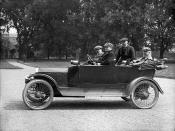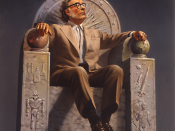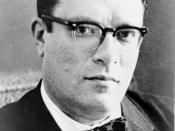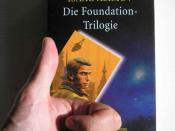The man himself said it best: Although I have written over a hundred and twenty books, on almost every subject from astronomy to Shakespeare and from mathematics to satire, it is probably as a science fiction writer that I am best known. (The Rest of the Robots 1) The staple of Asimov's works is the all-human universe, where robotics is an established science and Earth seems alone in the galaxy. In a time when most science fiction consisted mainly of meetings with fantastic, and sometimes monstrous, alien beings, Asimov built the majority of his works on a foundation of humanity and machines. This distinctive style of science fiction was being developed in his mind long before he began to write professionally, and it continued to be affected by the events and people around him.
When Asimov read science fiction as a boy, most of it was very fantastic in style, with little or no basis in real science at all.
There were the occasional exceptions, but the fundamental lack of science in these stories bothered Asimov (Kanfer 80). In fact, there was one particular aspect of the pulp science fiction he read regularly that he resented particularly, the style he dubbed the Frankenstein Concept (Fiedler, Mele 27): ...one of the stock plots of science fiction was that of the invention of a robot--usually pictured as a creature of metal, without a soul or emotion. Under the influence of the well-known deeds and ultimate fate of Frankenstein and Rossum, there seemed only one change to be wrung on this plot. --Robots were created and destroyed their creator; robots were created and destroyed their creator; robots were created and destroyed their creator.-- In the 1930s I became a science-fiction reader and I quickly grew tired of this dull hundred-times-told tale. As a person interested in science, I resented the purely Faustian interpretation of science. (Asimov, The Rest of the Robots 2) Because of this, coupled with his strong ideas of rationalism and logic, he strove to incorporate real science into his stories.
Asimov once reminisced, "I began to write when I was very young--eleven, I think" (The Early Asimov 2). After becoming frustrated with the lack of books to read, young Asimov reasoned that, if he could write his own, he would have reading material available at his leisure. By the time he was fourteen and in high school, he thought very highly of himself as a writer and jumped at the chance to sign up for a special class to show off his abilities. It was a choice he would regret: In the spring of 1934 I took a special English course given at my high school...that placed the accent on writing....It was a humiliating experience. I was fourteen at the time, and a rather green and innocent fourteen. I wrote trifles, while everyone else in the class (who were sixteen apiece) wrote sophisticated tragic mood pieces. (Asimov, The Early Asimov 3) His teacher was terribly callous about tearing his work to shreds, and as for his classmates, "[They] made no particular secret of their scorn for me..." (Asimov, The Early Asimov 3).
In 1938, when Asimov was eighteen, he submitted stories to John W. Campbell, Jr., at the Street & Smith publishing house. For seven months, each work Asimov sent in was rejected and sent back with a great deal of helpful criticism (Morton 84-5). The first of these was a short story entitled "Cosmic Corkscrew," which even the author later admitted was totally impossible (The Early Asimov 4-9). Young Asimov saw this submit-and-reject correspondence as the perfect apprenticeship because he received more help and advice than if his fiction had been accepted right away (Morton 84-5). After finally making it into published science fiction writing--after his second story, "The Callistan Menace," was printed--Asimov took on Campbell as his mentor and editor. It remained this way for years. Campbell helped the blossoming writer and encouraged his ideas. By training, the man was a scientist, having studied physics as M.I.T. and Duke.
This, coupled with an active imagination, decided how he helped Asimov along, nurturing his creative enthusiasm (Morton 86). As Oliver Morton aptly stated on Campbell's scientific method: [Campbell] would take an idea that fascinated him and test it empirically, trying it out on various different authors in his stable and taking notes of how it flourished or failed in different conditions. (86) At first, Asimov used aliens in his work like many other authors at the time, mainly to provoke curiosity about the true nature of intelligence and question the popular assumption that human beings were superior in all ways to other life forms (Fiedler, Mele 18-9). Examples of this include stories such as "Each an Explorer," in which he endowed plants with superior intelligence to that of humans. Another, entitled "Hostess," involves man's infection of other alien worlds with a deadly virus. Other examples include "The Deep," "The Martian Way," "Nightfall," and The Gods Themselves (Fiedler, Mele 16-8).
This changed, however, as he continued to work with Campbell. Asimov began writing science fiction in the late 30s and early 40s, when World War II was beginning in Europe. Campbell was very pro-human in his stories and eurocentric in real life, reflecting the Aryan ideals of the Nazis at the time. He disagreed with Asimov's ideas that humans may not have been the best and brightest species in the galaxy. Asimov, a Jew, felt that simply agreeing to Campbell's ideas in his stories would be wrong, so he, not wanting to promote any Aryan ideas in his stories, eliminated the interaction between humans and aliens, at least when working with Campbell, and focused on the role of human beings alone, using robots to replace aliens in the subservient role (Toupounce 8).
Asimov's adoption of the all-human universe satisfied Campbell. Using robots in place of inferior aliens, which Asimov had no problem doing, he was able to write without violating his beliefs (Toupounce 8-9).
Stemming from his childhood need for real science in science fiction stories, Asimov immediately set out to secure robotics as a "serious science," complete with a set of guidelines. Asimov established at the beginning of I, Robot, one of the earliest collections concerning robotics, rules to be followed regarding the imaginary branch of science. This established robotics as a legitimate science in his universe (Toupounce 33-4). The laws were as follows: 1. A robot must not injure a human being or, through inaction, allow a human being to come to harm.
2. A robot must obeys the laws given it by human beings except where such orders would conflict with the First Law.
3. A robot must protect its own existence as long as such protection does not conflict with the First or Second Law. (Toupounce 33) Even if he did not realize it at the time, Asimov was making an important contribution to science fiction. Later on, though, he came to know how greatly his guidelines had affected the genre. As Fiedler and Mele quoted of the man, "'If in future years, I am to be remembered at all, it will be for [the] three laws of robotics'" (27). Examples of Asimov's legendary robots stories, the first and best of which are collected in the book I, Robot, include "Reason" and "Escape" (Fiedler, Mele 27-31). In these tales of increasingly complex machines, the themes of the stories grew in involvement, as well.
The first robot story, "Robbie", dealt with the simple issue of trust. As Asimov wrote on, the ideas contained in his works evolved from this simple beginning to things such as invisible conspiracies, man's inability to control destiny, and even the delusional nature of religion (Fiedler, Mele 27-35). Ironically, it was this development in his robot writings that led him full circle and returned to that "Faustian mold" that he had detested so much reading as a boy. It was addressed in "The Evitable Conflict," the last of the robot stories in the I, Robot collection. Asimov returned to the age-old archetype of earlier robot stories. His take on it, however, is far more awe-inspiring than those of the pulp magazines of his youth, even if only for all the effort made to reach that point and not for the flawless, almost poetic, execution (Fiedler, Mele 35). However, it was not only Asimov's great harnessing of the robot sub-genre, but also his seemingly simple yet fundamental contribution to the vocabulary used in these stories. It was in his earliest works that he invented the "positronic brain" and even the term "robotics" itself (Fiedler, Mele 27-39).
All this is not to say, though, that Asimov invented the whole concept of robots in stories. Far from it. Before he began to write, even before pulps or anything of that nature existed, robots were regular components of fiction. They were mentioned in Homer's Iliad, as golden maidens created to serve Hephaestus. There have been stories of the bronze Talos of Crete and Golems made of clay, all down through the ages, so while Asimov did not create the concept, he did revolutionize it for the 20th century to enjoy (Asimov, The Rest of the Robots 4).
Despite a twenty-four year lull in Asimov's stories after 1958, he never lost his love for the idea. Consequently, he finally began work on his third robot novel, following the first two, The Caves of Steel and The Naked Sun. It was to be called The Robots of Dawn (Asimov, I. Asimov 473-7).
This did not stop him, in the 1980s, from dabbling for a short time in the realm of fantasy. He did this despite his firm support of logic and reason. After he was done with this experiment, there was enough to collect in another compilation book of stories about a tiny demon named Azazel. In fact, Asimov enjoyed writing mysteries, as well as his beloved science fiction tales. As a writer, he was very flexible, refusing to be restricted to one particular style (Asimov, I.Asimov 489-91).
"'The future is full of impossible possibilities,'" Asimov once said (Kanfer 82).
This simple, and true, statement was full of hope for the future, futures which he created in his writings. He was always looking forward. Because of this, he knew by the late 80s that his time had almost come. Asimov died on April 6, 1992, from heart and kidney failure. Being a man of reason, he had resigned himself to this fate long before. He knew that, unlike his fiction, there would be no miraculous machines to prolong his single human life. Even if there had been, he surely would have wanted none of it. Asimov, in the end, was content to be a part of the human pattern, the legacy he was so sure would prevail.
Works Cited Asimov, Isaac. I. Asimov. New York: Bantam Doubleday Dell, 1994.
Asimov, Isaac. Introduction. The Rest of the Robots. New York: Acacia Press, Inc., 1968.
Asimov, Isaac. Preface. The Early Asimov. Garden City, New York: Doubleday & Company, Inc., 1972.
Asimov, Janet. Epilogue. I. Asimov. By Isaac Asimov. New York: Bantam Doubleday Dell, 1994.
Fiedler, Jean, and Jim Mele. Isaac Asimov. New York: Frederick Ungar Publishing Co., 1982.
Gunn, James. Isaac Asimov: The Foundations of Science Fiction. New York: Oxford University Press, 1982.
Kanfer, Stefan. "The Protean Penman." Time 132 (December 19, 1988): 80-2.
Morton, Oliver. "In Pursuit of Infinity." The New Yorker 75 (May 17, 1999): 84-9.
Toupounce, William F. Isaac Asimov. Boston: Twayne Publishers, 1995.





